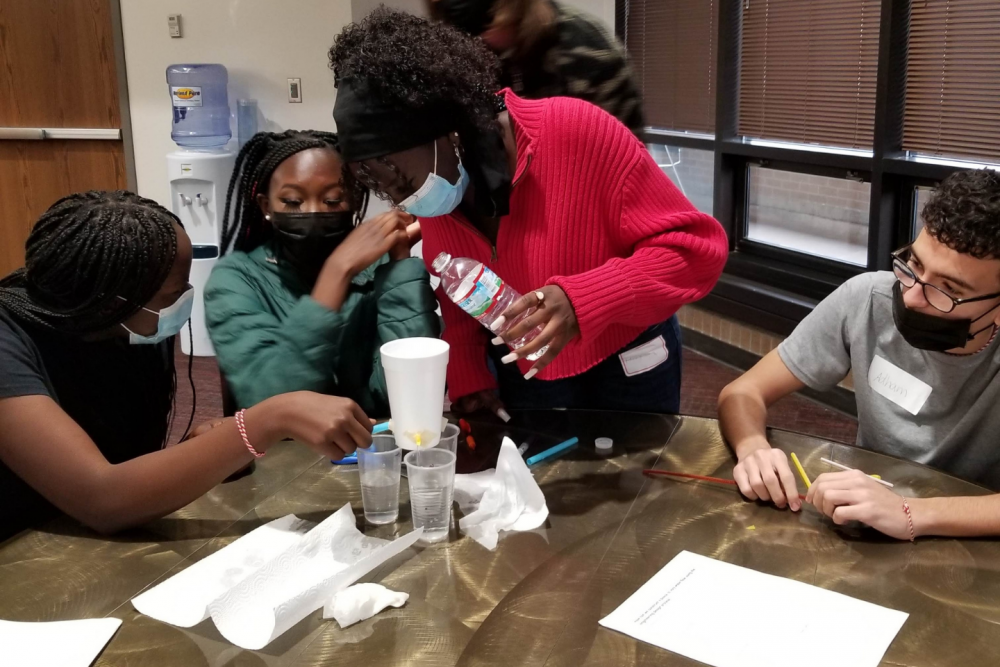
In this hands-on lesson, students will learn how precision agriculture uses geographic information systems (GIS) to help farmers and manufacturers make smart, efficient, and responsible decisions about how and when they plant, grow, irrigate, harvest, and transport crops.
Estimated Time
One class period (60-75 minutes)
Student Learning Targets
Students will use an engineering design process to construct a simple variable rate irrigation design solution.
Students will perform calculations to determine water use efficiency of a variable rate irrigation system and to provide evidence for its purpose in agricultural production.
Key STEM Ideas
Engineering allows us to define and solve real-world problems. Engineering concepts are changing agriculture by applying technology to improve food production. New equipment allows farmers to put in less labor to achieve larger yields. Precision agriculture is a farming management concept based on observing, measuring, and responding to inter- and intra-field variability in crops. Variable rate irrigation is a type of precision agriculture that involves applying water at a variable rate along the center pivot rather than one uniform rate along the entire length of the system. Variable rate irrigation has many uses for applying water at different rates to wet areas, different soil types, and overlapping pivots.
Students' Prior Knowledge
Students are not expected to have any background knowledge on this topic prior to completing the lesson. Basic vocabulary terms are listed in the presentation to review during lesson.
Students will learn the following in the lesson: Variable rate irrigation is made possible by the use of the GPS, field computer, rate controller, telematics, and meter. GPS is used by farmers to create field maps to determine a field’s boundaries. Field computers allow farmers to control the application of fertilizers, herbicides, and pesticides through automated delivery systems. Farmers are able to monitor yields and moisture using computers. Rate controllers make it possible for farmers to control how much irrigation, fertilizer, etc. is applied in a field. Telematics allows information collected in a field to be transferred in the internet.
Water use efficiency is calculated by determining the difference between irrigated yield and dryland yield and dividing that by the irrigation in inches. By performing these calculations, farmers will discover how much they should irrigate a section in order to increase yields and save water.
Connections to FEWSS
Agriculture has changed dramatically throughout the past years. In the past, almost everyone was a farmer. These farmers produced a variety of crops and livestock that they fed to their immediate families. Today, only 2% of the population is involved in production agriculture. These farmers have specialized operations and feed 155 people (Prax, 2010).
In order to accomplish this increase in agricultural productivity, farmers/ranchers use technology to increase their outputs with fewer inputs while using the same amount of space. Precision agriculture allows farmers to produce more using fewer resources, and variable rate irrigation is a great example of farmers using this technique.
Curriculum ConnectionsNext Generation Science Standards
- MS-ETS1-2. Evaluate competing design solutions using a systematic process to determine how well they meet the criteria and constraints of the problem.
Common Core Standards
- CCSS.Math.Content.7.EE.B.4 Use variables to represent quantities in a real-world or mathematical problem, and construct simple equations to solve problems by reasoning about the quantities.
- Student Resources (Word Doc) (1.13 MB)
- Student Resources (PDF) (582.43 KB)
- Teacher Resources (Word Doc) (1.27 MB)
- Teacher Resources (PDF) (793.22 KB)
- Powerpoint Presentation (30.72 MB)